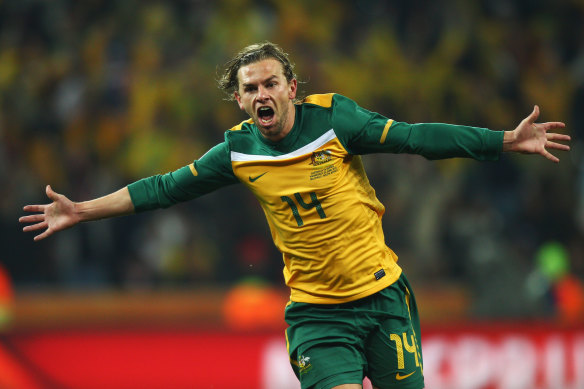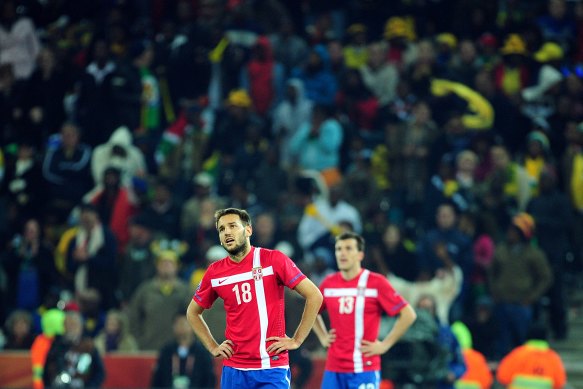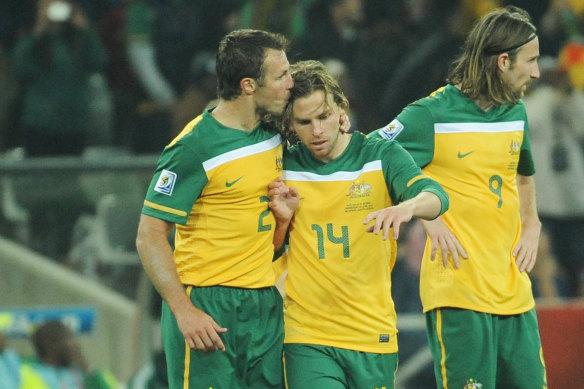This was published 2 years ago
Australia’s 12-year World Cup win drought – and how 11 ‘boxing kangaroos’ can end it
By Vince Rugari
Nelspruit. Wednesday, June 23, 2010. The Socceroos trudge off the pitch, hearts broken but heads high. They had just beaten Serbia 2-1 in their last group match at the World Cup in South Africa but fell short of reaching the knockout phase on goal difference. The feeling was bittersweet.
It was Australia’s second win in World Cup history, and the last signature achievement by the nation’s “golden generation”, most of whom retired soon afterwards. The future seemed bright enough at the time.

Brett Holman’s goal at the 2010 World Cup sealed just the second win for the Socceroos at the tournament - and it’s been a long time between drinks.Credit: Getty
“Timmy Cahill played on, but there was no one else ... [aside from] myself and Mile Jedinak, who obviously took the reins and became captain,” former Socceroo Brett Holman said.
“But the players under us, we were like, ‘Hey, we’re actually OK. There’s some good players coming through.’ ”
More than 12 years later, the wait continues. The Socceroos haven’t won a World Cup match since. In truth, they haven’t come close, losing all three games at Brazil 2014 and coming away from Russia 2018 with one point.
Could the drought end this month, in their fifth consecutive appearance?
Expectations for Graham Arnold’s men, who begin arriving in Qatar over the next few days, are not particularly high. After a torturous qualification campaign, it’s a minor miracle they will be there at all – and it’ll be a bigger one if they get out of a group that features reigning world champions France, Denmark – a dark-horse team filled with UEFA Champions League players – and Tunisia, who look beatable enough on paper but possess threats that shouldn’t be underestimated.
Arnold’s squad of 26 is probably the weakest, on paper, Australia have taken to football’s showpiece event – but ask Holman, the scorer of the goal that sealed that historic result against Serbia, and if the Socceroos conjure the spirit of Nelspruit, anything is possible.
The outlook, back then, was pretty bleak, too. After a 4-0 hiding against Germany in their opening match in 2010, which was preceded by a mutiny from senior players over coach Pim Verbeek’s tactics, Australia restored pride in a 1-1 draw with Ghana, most of which they played with 10 men after a first-half red card to Harry Kewell for handball. They were left needing to make up a goal difference buffer of four in their final Group D fixture to have any hope of finishing second and reaching the round of 16 – or hope Ghana did them a favour by upsetting Germany in the other game.
Serbia were coming off a 1-0 win over the Germans, their first against Die Mannschaft in 37 years. Milos Ninkovic played 70 minutes in that victory and the full 90 against Australia – a country he would come to know well in subsequent years. Serbia needed to beat the Socceroos to finish in the top two.

A dejected Milos Ninkovic reacts to Australia’s opening goal in 2010.Credit: Getty
“I remember that game like we played it yesterday,” he said. “When I speak with some other players like [Dejan] Stankovic and [Nemanja] Vidic, they said, ‘If I could pick one game to play again, I would pick the game against Australia’. Everyone says that.”
The Socceroos were under siege early. Ninkovic regards the first half as the best Serbia played throughout 2010. Only the goalkeeping heroics of Mark Schwarzer, repelling one-on-one chances from Milos Krasic, kept the scores level at the break – and Australia in the contest.
In the space of four second-half minutes, though, it swung Australia’s way. Luke Wilkshire floated in a cross from the right, and Cahill contorted his body, got his head on the ball and gave the Socceroos the lead.
Then Holman, just moments after entering the fray off the bench, scored the goal of his life. Collecting the ball near the centre circle as Australia transitioned into attack, he galloped forward, looked up and had a go from 25 metres out.

Lucas Neill shows his appreciation for Brett Holman after his goal put Australia 2-0 up.Credit: Vince Caligiuri
He says he’s never hit a ball so cleanly – but also suspects it had a bit to do with the controversial Adidas Jabulani ball used at the tournament, which flew so unpredictably players compared them to the plastic footballs often sold at supermarkets.
“My old man always used to say, ‘You don’t need to walk it in, just have a crack’. It was a cracking strike, the best feeling ever,” he said.
But that was it. Marko Pantelic’s 84th-minute goal for Serbia killed the dream there and then for the Socceroos.
In the Socceroos’ six World Cup matches since, they have held the lead for a grand total of four minutes – the time between Mile Jedinak’s penalty and Robin van Persie’s quick reply for the Netherlands in Porto Alegre at the 2014 World Cup under Ange Postecoglou.
The financial impact of the pandemic may have slightly opened up the developmental bottleneck in the A-League, and a new generation of exciting young players seems to be emerging as a result, but that won’t help Arnold in Qatar – even if arguably his best weapon on the bench is Garang Kuol, the 18-year-old jewel on his way to Newcastle United in January.
Cahill is more optimistic. “Twelve years is too long, for sure,” he said.
“I’d love to see us go further than what we did in 2006. Someone will turn around and say to me, ‘Look at the squad, look at the differences’. But you actually have to move on from the past. You have to look at what you have in front of you. There’s not loads of [star] individuals. But together, collectively, when you look at the final performance against Peru, there’s definitely something there. I think we have a good crop of boys to pick from, and now it comes down to how that works together.”
Holman can draw a straight line from what motivated the Socceroos against Serbia to what Arnold will be looking to draw from his players in Doha.
AUSTRALIA’S 26-MAN WORLD CUP SQUAD
Goalkeepers: Mathew Ryan, Danny Vukovic, Andrew Redmayne
Defenders: Harry Souttar, Kye Rowles, Milos Degenek, Bailey Wright, Thomas Deng, Nathaniel Atkinson, Fran Karacic, Aziz Behich, Joel King
Midfielders: Aaron Mooy, Jackson Irvine, Cameron Devlin, Ajdin Hrustic, Riley McGree, Keanu Baccus
Forwards: Jamie Maclaren, Mitchell Duke, Jason Cummings, Mathew Leckie, Garang Kuol, Craig Goodwin, Awer Mabil, Martin Boyle
It’s cliche, he says, but it’s true: the Aussie spirit is a real thing, and it works.
“You don’t teach these footballers how to play football at that level, once you’re there,” he said. “It’s getting them up and saying, ‘OK, we’re wearing the green and gold, and we’re not going to give them anything’. They’re simple words but it’s always worked, and it’s always been something that has been used in all the games that I’ve experienced.”
Arnold was there, too, against Serbia as an assistant to the late Verbeek, who died of cancer in 2019. He has spent the past four months interviewing Socceroos staff members from previous World Cup campaigns and interrogating his own memories to find out where things could have gone better, and what exactly he can change to bring that next win closer.
“Qualifying for me is just not enough – it’s great that we’ve done it, we put money in the bank, it puts a great shine on the sport. But how great would it be if we win a few games?” he said.
Arnold was also at the last World Cup in Russia, where he was watching Bert van Marwijk’s work with a critical eye as he prepared to take over after the tournament. “I thought France, we probably gave them too much respect. We tried not to lose. Denmark the same,” he said.
“A lot of times those big nations are slow starters. We need to start strong. I think a lot of people get overawed by the name. It’s 11 yellow shirts against 11 blue shirts, and it’s about winning those individual battles in that fight. Bring back the boxing kangaroo, bring back the fighters, the fighting Socceroos – that’s in our DNA, and always has been.”
Holman agrees, although he is concerned about the lack of big-game experience in Arnold’s squad, which features 17 World Cup debutants.
“There’s no churches in Qatar. So we can’t go and pray or anything,” he laughed.
“France is going to be, obviously, so difficult – even with their injuries, you see the quality. You almost need to start conservative, try and get anything out of that game, and then at least you know you’ve got two games, and you’re still in it.”
If nothing else, those players will come away from Qatar better equipped for the next World Cup cycle.
“Some of these boys, in a perfect scenario, could play three or four World Cups ... it’s only a positive I think,” Holman said. “OK, great – but let’s rock on and get a win as well. And we can forget about Serbia, once and for all.”
Watch every match of the UEFA Champions League, UEFA Europa League and UEFA Europa Conference League on Stan Sport. Returns for the Round of 16 in February 2023, with all matches streaming ad-free, live and on demand.
To start your 7 day free trial, visit Stan.com.au/football
Sports news, results and expert commentary. Sign up for our Sport newsletter.